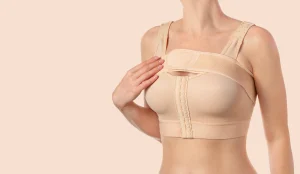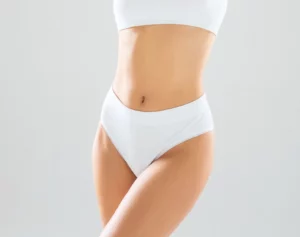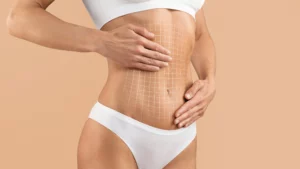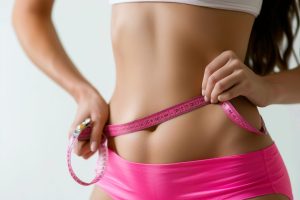When most people think of a tummy tuck, they imagine skin tightening from the lower abdomen downward. However, a reverse tummy tuck, also called a reverse abdominoplasty, focuses on lifting and tightening the upper abdominal area instead. Rather than pulling skin downward toward the pubic line, this procedure elevates excess skin toward the breasts or chest, offering an effective solution for individuals struggling with upper abdominal laxity. In simple terms, a reverse tummy tuck tightens the top of the stomach, especially when the lower area is already firm or has been treated before.
This surgery is ideal for those who notice sagging or skin folds above the belly button, often due to weight loss, aging, or previous procedures. Let’s explore more about this specialized procedure.
Understanding What a Reverse Tummy Tuck Does
A reverse tummy tuck removes and tightens excess skin in the upper abdomen, just below the breasts. Rather than making an incision along the bikini line, the surgeon creates incisions along the inframammary crease – the natural fold beneath the breasts. This placement keeps the scar well hidden, especially for those who wear bras or swimsuits. A reverse tummy tuck is commonly chosen by people who have upper loose skin that diet, exercise, or non-surgical treatments cannot address.
This procedure does not typically reposition the belly button, since it primarily focuses on tissue above it. For patients whose upper and lower abdomen require correction, a reverse tummy tuck can be combined with a standard abdominoplasty.
Why Loose Skin Appears in the Upper Abdomen
Aging, genetics, pregnancy, and massive weight loss can all contribute to skin laxity. While countless fitness routines and skin-tightening treatments promise firmness, upper abdominal sagging often persists due to the natural loss of elasticity. Once skin has stretched beyond its recovery point, only surgical removal can restore a smoother appearance.
Individuals who have already lost weight or received lower abdominal surgery sometimes find the upper abdomen still lacks symmetry. This is where a reverse tummy tuck becomes a targeted solution, refining what non-surgical treatments cannot achieve.
How a Reverse Tummy Tuck Differs From Standard Tummy Tucks
A traditional tummy tuck addresses the entire abdomen, pulling skin downward and often repositioning the navel. In contrast, a reverse tummy tuck works in the opposite direction by elevating tissues toward the chest. For this reason, it can be an excellent alternative for individuals who only struggle in the upper section or who have already had prior lower abdominal procedures.
Who Needs a Reverse Tummy Tuck?
Not everyone with abdominal concerns is a candidate for this surgery. A reverse tummy tuck is specifically designed for individuals who struggle with sagging or stretched upper abdominal tissue while the lower abdomen is relatively toned. For example, someone who underwent massive weight loss may have folds of skin that gather beneath the bust line. Others may be satisfied with their lower stomach but unhappy with the loose, creased appearance above it.
The key benefit of this approach is precision. Instead of addressing the entire abdomen, it focuses solely on the region that needs improvement. This makes it different from broader forms of plastic surgery like full abdominoplasty, which treats both upper and lower areas.
Am I a Good Candidate for a Reverse Abdominoplasty?
Ideal candidates are typically adults who are in good health, non-smokers, and at or near their goal weight. They should have good skin elasticity in the lower abdomen, but noticeable drooping in the upper abdominal region. Those who have undergone significant weight loss, especially after bariatric surgery, often consider this procedure once they reach a stable weight.
Candidates must also have realistic expectations about the outcome. While the surgery can significantly improve contour and tightness, it is not a weight-loss method or muscle repair procedure. It strictly enhances skin appearance and upper abdominal definition.
Is a Reverse Tummy Tuck Painful?
A reverse tummy tuck is generally well-tolerated, but like any surgical procedure, it involves a recovery period. Most patients report mild to moderate discomfort in the first week, which is managed through prescribed pain relief and rest. Patients may feel tightness or pulling sensations when standing upright during initial healing.
However, recovery can often be easier compared to a full tummy tuck since there is no muscle tightening and the procedure does not involve the lower abdomen. Swelling and bruising are expected but gradually subside within a few weeks. Most people return to light activities within 10 to 14 days, with full recovery over six to eight weeks.
The Role of the Belly Button in a Reverse Tummy Tuck
While standard abdominoplasty often includes reshaping or repositioning the navel, a reverse tummy tuck leaves the belly button untouched. This is because the procedure operates above it, lifting tissue upward rather than downward. Patients who desire improvements around the navel or lower abdomen may combine procedures for a more uniform appearance.
When both the upper and lower abdomen need correction, surgeons may perform staged treatments or a full abdominoplasty instead. The decision depends on the skin quality, redundancy, and structural requirements of each patient.
Benefits of a Reverse Tummy Tuck
Patients often choose this surgery to regain confidence, wear fitted clothing comfortably, and achieve a balanced abdominal contour. Benefits include:
Upper abdominal tightening
Improved body proportions
Hidden incision placement
Compatibility with other cosmetic enhancements
Psychologically, patients report increased self-confidence after surgery, especially if loose skin was a long-standing concern. For many, it represents the final step after long-term weight goals or previous surgical transformations.
Recovery and Aftercare
Recovery involves limited arm and chest movement initially, especially to prevent stress on incisions below the breast fold. Surgeons typically advise sleeping in an elevated position, wearing compression garments, and avoiding strenuous exercise for several weeks.
Follow-up appointments ensure proper healing and scar management. Silicone scar treatments, massage, and sun protection help minimize visible marks over time. Most scars fade significantly within one year.
Schedule a Consultation with Our Board-Certified Plastic Surgeon
If you are considering a reverse tummy tuck, scheduling a consultation with our double-board-certified plastic surgeon, Dr. Erella, is the next important step. He has extensive skills in reverse tummy tuck procedures, helping patients address loose or sagging skin in the upper midsection that cannot be improved through diet or exercise alone. With a precise approach, he works to remove excess skin and fat while preserving the natural contours of the abdomen.
During your consultation, Dr. Erella will evaluate your concerns, including lax skin above the belly button, and discuss whether you are a good candidate for this corrective technique. He focuses on specialized procedures designed to enhance the overall body contour, often for individuals who have already achieved weight loss but struggle with persistent upper abdominal laxity.
Every patient receives a personalized treatment plan tailored to their goals, ensuring both aesthetic balance and functional improvement. With advanced skills in cosmetic surgery, Dr. Erella uses the latest techniques to minimize scarring, placing incisions strategically along natural creases for discreet healing. His meticulous surgical approach helps achieve a smoother, firmer upper abdomen while maintaining harmony with the rest of the torso.
If you’re ready to address the final step in your transformation and restore confidence in your appearance, a consultation with Dr. Erella will provide the guidance, honesty, and professionalism needed to make an informed decision about surgery.
Reverse Tummy Tuck Cost
The reverse tummy tuck cost varies depending on the surgeon’s credentials, geographic location, anesthesia fees, and whether combined procedures are performed. On average, patients can expect to pay from $8,000 to $15,000. When combined with other surgeries like a breast lift or liposuction, overall pricing will increase accordingly.
Patients should keep in mind that this is an elective, cosmetic procedure, which means insurance does not typically cover it. Investing in a qualified and experienced surgeon is crucial, as their professionalism directly influences safety, aesthetic outcomes, and scar placement.
Combining a Reverse Tummy Tuck with a Breast Lift and Mini Tummy Tuck
Some patients seeking comprehensive enhancement choose to combine a reverse tummy tuck with a breast lift or mini tummy tuck as part of integrated body contouring procedures. While the reverse tummy tuck offers correction for lax skin in the upper portion of the abdomen, pairing it with additional treatments can create a more seamless, toned appearance across the entire torso. This approach addresses multiple concerns in a single surgical plan, enhancing balance and proportion from the chest to the lower abdomen.
Setting Realistic Expectations for Plastic Surgery
While results can be transformative, patients should understand that surgery cannot create perfection. Skin quality, underlying structure, and individual healing all play roles in the final appearance. Discussing goals openly with your surgeon ensures clarity about what can be achieved.
Conclusion: Is a Reverse Tummy Tuck Right for You?
Reverse tummy tuck surgery provides a highly targeted solution for individuals struggling with excess upper abdominal skin, especially in cases where the lower abdomen is already firm or previously treated. Unlike traditional tummy tucks, which pull skin downward, the reverse tummy tuck focuses on lifting skin upward in the upper abdomen toward the breast crease (inframammary fold), refining contour, and eliminating excess tissue. Upper abdominoplasty allows the surgeon to tighten remaining skin and refine the transition between the chest and stomach while preserving natural proportions.
Performed under general anesthesia in an accredited surgical facility, the procedure is designed to address loose skin and restore a smoother, more youthful appearance. During recovery, pain medication is provided to manage discomfort, and patients are advised to follow post-operative instructions to promote optimal healing and minimize swelling. As the swelling subsides, the results become more defined, revealing improved upper abdominal contours and greater confidence in body appearance.
While surgery removes laxity and refines remaining tissue, long-term results are best maintained through a healthy lifestyle and maintaining a healthy weight. For those dealing with persistent drooping in the upper abdomen, this procedure offers a specialized approach that standard methods cannot achieve.










